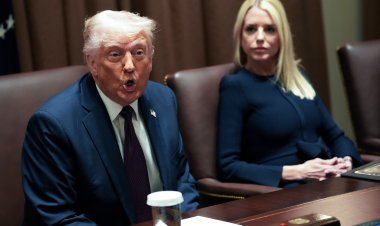`Canary in the coal mine': Warning signs for Trump in small business struggles
The levies are impacting a pivotal moment, as the smallest firms are experiencing a significant decline in headcount, a drop in revenue, and a decrease in confidence.

The mere threat of sweeping new trade levies had already created unease among small business owners, who are responsible for nearly half of all U.S. private sector jobs, over 40 percent of the nation’s annual economic output, and approximately one-third of American exports, well before Trump’s announcement.
On Thursday, the Russell 2000, which tracks shares of smaller companies, became the first major U.S. index to plunge into bear market territory, falling more than 20 percent since its peak shortly after Trump’s election. This decline is particularly troubling for smaller businesses, as it surpasses the losses experienced by larger corporations in the S&P 500 and Dow Jones Industrial Average.
Many small business leaders are likely to align with Republican values, suggesting that Trump may have more at stake politically with them than with other executives who oppose his tariffs. However, even major corporations have struggled to persuade policymakers to ease the mounting pressure.
“We’ve seen a parade of major corporations go to the White House urging restraint. It has had no effect,” commented Gary Locke, former Commerce secretary and ambassador to China during the Obama administration. “If these titans of industry don’t have much influence, how could representatives of small businesses, mom-and-pops?”
Trump’s tariffs are emerging during a pivotal time. A monthly small business employment tracker from Intuit QuickBooks reported a drop of nearly 100,000 employees in firms with nine or fewer workers in March, continuing a trend of declines from the previous year. A quarterly confidence index from the Chamber of Commerce and MetLife saw a dip in the first quarter of 2025. Additionally, a survey by regional Federal Reserve Banks revealed that, for the first time since 2021, a majority of small businesses reported decreased revenue.
Regarding small business hiring plans, “I’m not hearing ‘growth,’” noted Richmond Fed President Tom Barkin in an interview before Trump’s announcement. “I’m hearing ‘wait.’”
Even among participants in a National Federation of Independent Business survey, which has often shown optimism about Trump’s agenda, economic pessimism grew in the last month.
As the president committed to a series of tariffs, including steep duties on autos, steel, and aluminum imports, he and top administration officials stated the economy could weather any disruptions or price hikes.
“When the president of the United States is saying that something is going to raise costs, that scares small business,” remarked Tom Sullivan, vice president of small business policy at the U.S. Chamber of Commerce.
Trump contends that his trade policies will result in substantial benefits for U.S. businesses and the economy.
“For years, hard-working American citizens were forced to sit on the sidelines as other nations got rich and powerful, much of it at our expense,” the president stated Wednesday. “But now it’s our turn to prosper, and in so doing, use trillions and trillions of dollars to reduce our taxes and pay down our national debt, and it’ll all happen very quickly.”
Before Trump’s announcement, House Republicans expressed indifference to signs of weakness in the small business sector due to impending tariffs, asserting that tax reform and deregulation would enhance the outlook in the coming months.
Rep. Roger Williams, chair of the House Small Business Committee and owner of a Texas auto dealership, told PMG on Tuesday that Trump’s tariffs could lead to better consumer deals if businesses reduce prices to clear their inventories.
“I would be hit by tariffs [but I’m] not worried about tariffs, because people like me that have inventories, if we don’t sell it, we discount it,” the Republican stated. “The customer’s going to get a discount.”
Nonetheless, Wall Street economists caution that Trump's tariff strategy and potential retaliatory measures could result in increased inflation, diminished consumer demand, and an economic deceleration. If tariffs create both high prices and slow growth, the administration might face a political quandary related to stagflation, a condition not witnessed in the U.S. for over four decades.
Small businesses “are very sensitive to macroeconomic conditions,” stated Ufuk Akcigit, an economics professor at the University of Chicago who helped develop the Intuit QuickBooks employment tracker. “They are also typically like the canary in the coal mine. They are the first ones to be affected whenever things go badly.”
Most economists are not optimistic about small businesses navigating the forthcoming turbulence. Analysts at Goldman Sachs and JPMorgan Chase have increased their likelihood estimates for a recession in the next 12 months, and Wall Street is preparing for weaker earnings in the first quarter due to a slowdown in investment and deal-making. Bank of America economists predict “modest stagflation” as the most probable scenario this year, potentially constraining the Fed's ability to assist businesses with lower interest rates.
Bank lending criteria began to tighten even before fears of stagflation and recession intensified. Small businesses, depending more heavily on loans compared to their larger counterparts, may find themselves in a precarious situation as they confront rising input costs due to tariffs.
“They’re not like large corporations,” said Taylor Bowley, an economist at the Bank of America Institute specializing in small business banking data. It’s challenging for them to adapt their supply chains or pre-purchase inventory to stay ahead of new trade barriers.
“They operate on very thin profit margins,” Bowley observed. “Frankly, they just don’t have the bandwidth or operating expenses to do that.”
Camille Lefevre for TROIB News
Find more stories on Business, Economy and Finance in TROIB business












